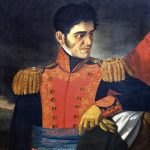Mexico’s French Pastry War
By Herbert W. Piekow

A French pastry chef claimed his business had been destroyed by Mexican officers, of course he did not know whom the officers supported, only that they had looted and vandalized his business. I suspect they probably took his entire ready to sell croissants, fresh bread, and macaroons and possibly smashed the place up a bit to teach the arrogant Frenchman a lesson. I can say this because I am half-French and understand how easily we can overreact to imagined affronts.
Anyhow, Monsieur lePâtisserie put in a claim for damages to the Mexican government for $60,000 pesos, at a time when most Mexicans earned only a peso a day. Of course the Mexican government ignored this claim, as it did most claims from private citizens. The same claim was presented by this obnoxious baker to the French government, who also politely ignored the claim of their former citizen.
Ten years later, in 1838 the frustrated, ignored but persistent pastry shop owner petitioned the French King Louis-Phillipe, in those days, before countries had consuls, the foreign residents of one country often communicated directly with their homeland governments. The French King was interested in this insignificant claim, the French wanted to wheedle their way into Mexico and the Mexicans also owed some unpaid debt incurred during their struggle for independence.
Suddenly the original $60,000 pesos claim escalated to $600,000, not including the several million dollars that Mexico had earlier borrowed in their fight for independence from Spain. Mexico refused to pay this exorbitant amount for a destroyed pastry shop, and besides the baker had since moved on.
In 1838, France blockaded the entire Eastern Coast of Mexico from the Yucatan to the Rio Grande. The blockade hurt Mexico´s fragile economy because Veracruz was Mexico´s busiest seaport and the revenues from trade and travel abruptly ceased. Actually Veracruz remained Mexico´s busiest seaport until the 1950´s.
The United States was interested in Mexican territory and so the US supplied several ships to aid France´s blockade. One US ship was an extremely fast armed cutter named The Woodbury, named after the United States Senator Levi Woodbury. With trade cut off the Mexicans began to smuggle supplies into Corpus Christi, Texas and back into Mexico. The Texans feared that France would also block all the Texas ports and so a battalion of men from the Republic of Texas began patrolling Corpus Christi Bay to stop the Mexican smugglers.
Flour Bluff of Corpus Christi received its name because a smuggling party abandoned their cargo of one hundred barrels of flour on the beach at the mouth of the bay. Imagine all the petite gateaux, macarons, Madelines and beignets those barrels of flour could have produced. A funny side note is that beignets are popular almost worldwide, in some form or other. Here in Mexico we call this fried dough mixture churros, but wherever they are fixed, the finishing touch is to roll them in a sugar cinnamon mixture before enjoying.
In November of 1838 the French invaded Veracruz and overwhelmed the small Mexican Navy. The French destroyed the Mexican fortress of San Juan de Ulúa, which had guarded Veracruz since its founding, and had repelled pirates and invaders for several hundred years. Today the fortress remains are a national landmark. The 30,000 strong French forces completely destroyed Veracruz and all but annihilated the 3,000 strong Mexican forces.
When the retired generalissimo Antonio López de Santa Anna heard of the destruction of Veracruz and the obliteration of San Juan de Ulúa, he rallied a small army to avenge the Mexican pride. Incredibly this was done without the support of the Mexican Government; they later paid for this expedition. Santa Ana and his troops were Mexico´s only hope in reclaiming the city. However, his army was small and the French were entrenched in what remained of Veracruz. Half of Santa Anna´s forces were either injured or killed and Santa Anna himself suffered the loss of a leg. Despite his defeat he parlayed his amputation to become a national hero.
With England´s intervention, the French left but only after Mexico agreed to pay the $600,000 pesos and the French expenses for the blockade. Nothing was mentioned about repaying the other debts. Although the French forces left on March 9, 1839, the French continued to be an influence in Mexico´s culture. Mexican bakeries sell éclairs and croissants; in Mexico we call them croissantscornos, because of their horn shape.
The French or Napoleonic Judicial code is the basis of the Mexican legal system and what we sometimes think of as late colonial architecture is in fact French in design and influence. When Maximilian was Emperor of Mexico, he was supported by French forces. President Porfirio Diaz was a Francophile and his tastes were reflected in the splendid architecture and stylish furnishings that grace Mexico to this very day.
- April 2024 – Issue - March 31, 2024
- April 2024 – Articles - March 31, 2024
- April 2024 - March 31, 2024








